A Comprehensive Guide to Various Pet Bird Species


Intro
Keeping a pet bird can be a rewarding experience, allowing individuals to share their lives with these vibrant and intelligent creatures. Each bird species comes with its own set of characteristics, behaviors, and care needs that can be quite distinct. For those considering avian companionship, or even for seasoned bird owners, understanding these differences is crucial.
Birds can offer companionship and joy, while also requiring specific attention to their habitat, social behavior, and diet. Throughout this guide, we will explore various pet bird species, diving into their unique attributes and the comprehensive care they demand. By the end of this article, readers will not only have a better grasp of what it means to own a pet bird, but they'll also be equipped with the knowledge necessary to foster a healthy and fulfilling relationship with their feathered friends.
"Birds are not just pets, they are family members that bring life and joy into our homes."
Understanding the nuances of pet bird ownership is the first step toward ensuring that these creatures thrive in an environment that caters to their needs. This guide aims to provide insights and tips that will enhance your experience as a pet bird owner, from habitat and nutritional requirements to behavioral insights and health considerations.
Prologue to Pet Birds
When it comes to domestic companions, few can match the charm and vibrancy of pet birds. Owning a feathered friend is not just about having a small creature flitting about your home—it’s about forging a bond that can bring joy, companionship, and a sprinkle of color into the everyday grind. In this section, we’ll explore the many reasons why pet birds captivate the hearts of people worldwide, and what to consider before making one part of your family.
The Appeal of Avian Companionship
Birds are often perceived as enchanting and dynamic, with their beautiful plumage and melodic songs. You can hardly ever be bored when you have a pet bird; they can exhibit a range of personalities, from the curious and playful parakeets to the affectionate cockatiels. Each species adds a unique flavor to the atmosphere of a household.
The companionship birds provide is multi-faceted. Many pet bird owners report feelings of happiness and stress relief from interacting with their birds. There’s something soothing about watching a budgerigar pirouette or listening to a canary sing sweet melodies. These little creatures can sometimes be a source of laughter, entertainment, and lightheartedness during trying times.
Among the various traits that make birds appealing, their ability to bond with humans is particularly noteworthy. Birds often recognize their owners, responding to your voice or entering an affectionate state when held close. Such connections can be quite profound, often challenging the notion that pets only come in furry varieties.
However, it is vital for potential owners to remember that bird ownership isn’t simply about aesthetics or amusement. It involves a meaningful commitment that affects both your lifestyle and your well-being. This decision shouldn't be made lightly. Consider the time it takes to care for them properly and understand their needs, like social interaction, diet, and proper habitat.
Choosing the Right Pet Bird
Selecting the right pet bird can feel a bit like finding a needle in a haystack. With so many species available, it's vital to take the time to consider different factors that could lead to a harmonious pet-owner relationship. Birds are not just charming companions; they possess diverse personalities, care needs, and social dynamics. This section will provide insights into what influences your choice of bird, along with understanding the long-term commitment that owning birds entails.
Factors Influencing Your Decision
When it comes to picking a pet bird, several elements can sway your decision-making. Here are some key aspects to mull over:
- Space: Consider how much room you have. Smaller birds like budgerigars might need less space compared to larger birds like macaws. If you're in a tiny apartment, a compact cage for a finch could be the answer.
- Time Commitment: Birds, especially social ones like cockatiels, require daily interaction. If your schedule is packed tighter than a tin can, you might want to opt for a species that thrives with less human interaction.
- Noise Level: You may not think about it at first, but some birds are louder than a rock concert. African Grey Parrots are particularly vocal. Make sure you check your own tolerance for potential noise.
- Care Needs: Different species have diverse dietary and habitat needs. For instance, canaries eat a seed-based diet, while lovebirds have more varied requirements. Be prepared to dig into the specifics to make an informed choice.
- Allergies: Some folks might be allergic to bird dander. It is good to check for sensitivity before bringing a feathered friend into your home.
Long-Term Commitment Considerations
Owning a pet bird isn't a short-term fling; it’s a serious, long-term commitment. Birds are known for their longevity—some can live for decades. So, before you take the plunge, consider the following:
- Lifespan: Many birds, like macaws, can live for 50 years or more. Ask yourself if you can commit to caring for a pet for possibly the rest of your life. It could be quite a journey and the feathered companion could become a true part of the family.
- Health Care: Like any other pet, birds can experience health issues. Being prepared for veterinary visits and regular check-ups is essential. Make your appointments with avian vets to ensure your bird stays in top shape.
- Lifestyle Changes: Your life may shift—new jobs, relocating, having kids. Consider how these aspects might impact your ability to care for a bird. Are you going to have time for your companion, or will it take a backseat?
- Emotional Commitment: Birds require emotional investment. They thrive on affection and can become quite attached to their owners. The bond you build will be crucial, so be ready for a little heart investment.
In summary, choosing the right pet bird isn't just about finding a colorful companion to sit on your shoulder; it’s about understanding your own life, the bird’s needs, and how they’ll intertwine for years to come. Remember, every choice carries weight, and being informed about your options will pave the way for a fulfilling relationship with your avian friend.
Small Birds
Small birds are often the gateway into the world of avian companionship. Their diminutive size, charming personalities, and relatively easy care make them an appealing choice for both novice and seasoned bird enthusiasts. A dive into small birds reveals not just their aesthetics but also their social significance, care needs, and varied behaviors. These lovely creatures can brighten up a home and offer companionship, enriching the lives of their owners in unique ways.
Budgerigars
Preamble to Budgerigars
Budgerigars, commonly known as budgies, stand out as one of the most popular pet birds worldwide. Their vivid colors and playful natures make them a favorite among bird lovers. A significant characteristic of budgerigars is their adaptability in various environments. This quality not only makes them appealing but also allows them to thrive in different home settings. Moreover, budgies are relatively affordable and come in various colors, which enhances their appeal.
An interesting feature of budgerigars is their ability to learn to mimic sounds, which can be entertaining for their owners. However, their social needs require consideration; they thrive when they have interaction, either with humans or other birds.
Care Requirements
Proper care is essential for budgerigars to remain healthy and happy. Their care requirements include a spacious cage, quality diet, and daily out-of-cage time for exercise and interaction. A key aspect generally involves keeping their environment clean and safe to prevent illnesses, which could be detrimental to these small creatures.
Ultimately, understanding their specific care needs is fundamental for any prospective owner. A unique factor is that they do require mental stimulation; boredom can lead to negative behaviors. Owners must provide toys and engaging activities to avoid such issues.
Common Behaviors
Budgerigars are known for their lively and sociable behaviors. Understanding what budgerigars exhibit on a daily basis offers insights into their personalities. They are naturally curious, often exploring their surroundings and engaging with their owners.
Another characteristic to highlight is their tendency to form strong bonds with their human caregivers, which can turn into a beautiful relationship. However, their sociable nature means they can also feel lonely if left alone too frequently. Providing companionship, whether through play or even another budgie, can substantially improve their well-being.
Canaries
Types of Canaries
Canaries vary significantly in type, from the familiar song canaries to the beautiful color canaries. This diversity plays an important role in their popularity among avian enthusiasts.
One notable type is the Gloster, known for its unique crest, while the Harlequin is often prized for its vibrant colors. Each variety has its own appeal and care requirements, making it essential for potential owners to understand these differences. The variety can contribute to a more personalized pet ownership experience, catering to individual preferences.
Diet and Nutrition
The dietary needs of canaries are crucial for their health. A balanced diet typically consists of commercial seed mixes, supplemented with fresh fruits and vegetables.
Highlighting the need for a proper diet, seeds alone will not suffice for their nutrition. For example, providing leafy greens like kale or dandelion can improve their overall health and vitality. One risk to consider is that improper diet could lead to health problems, making awareness and education critical for effective pet ownership.
Cage Setup
Creating an appropriate habitat is vital for canaries. The cage should be spacious enough to allow for flight and play. A good characteristic of an ideal cage setup is the presence of horizontal bars, as canaries enjoy climbing.
An interesting feature of canary housing is the option for various enrichment items like perches of different sizes. These can encourage natural behaviors and prevent boredom. One downside can be the initial investment in a good-quality cage and accessories; however, the rewards often outweigh the costs in the form of a healthy, active bird.
Finches
Popular Finch Species
Finches bring a delightful array of colors and sounds. Among the most popular species are Zebra Finches and Society Finches. Each type brings its own charm and unique needs, contributing to the variety in the pet bird segment.
Zebra Finches, in particular, have the added appeal of their melodious chirps, which many find delightful. Potential finch owners must consider compatibility in species, as some may not coexist well together. Understanding these nuances helps foster a harmonious environment, whether it's a single-species setup or a mixed aviary.
Social Interaction Needs
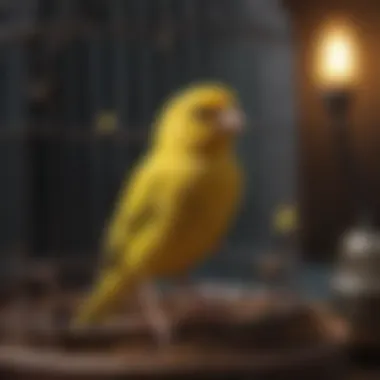
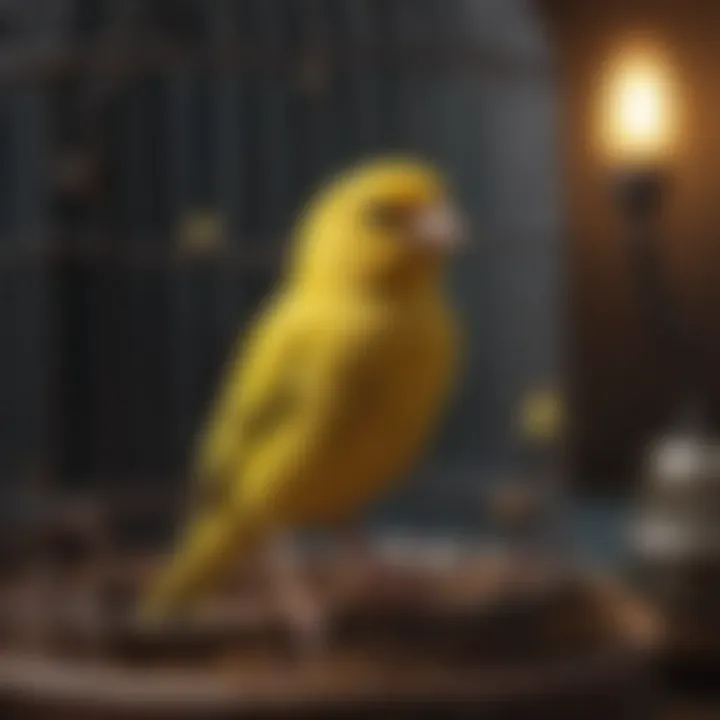
Social interaction is crucial for finches. Generally, finches thrive in groups; they are social creatures that often engage in playful antics with one another.
A key point to remember is that solitary finches may become stressed or develop behavioral issues. Observing their interactions can be a rewarding experience, not only for the birds but for the owners as well.
Socializing finches with care can boost their happiness levels immensely, often leading to healthier and more vibrant birds.
Breeding Information
For those interested in finch breeding, understanding their reproductive habits is essential. Many finch species breed readily given the proper conditions such as a suitable nest and a balanced diet.
A unique aspect of finch breeding lies in their tendency for communal nesting, where multiple pairs may share a breeding space. This cooperative behavior can provide a unique dynamic among your birds but can also lead to complications.
Notably, breeding requires a deep understanding of their needs, monitoring for possible conflicts, and ensuring the health of both the chicks and parents, which can be a rewarding journey for dedicated owners.
Medium-Sized Birds
Medium-sized birds hold a unique position in the realm of pet ownership, bridging the gap between the small, delicate species and the large, often demanding parrots. With characteristics that include vibrant personalities and diverse social behaviors, these birds can fit seamlessly into a household dynamic, providing companionship without overwhelming the owner. Their social nature, intelligence, and interactive potentials make medium-sized birds, like lovebirds and cockatiels, a popular choice for many bird enthusiasts.
Lovebirds
Understanding Lovebird Behavior
When it comes to understanding lovebirds, one must recognize their intense social nature. Lovebirds are often described as affectionate and playful, engaging in behaviors that showcase their emotional bonds, whether it's through mutual preening or playful tussles. This characteristic makes them not just pets, but rather true companions in the household, contributing significantly to the overarching theme of avian companionship explored in this article.
A unique feature of lovebirds is their propensity to develop a deep attachment to not only their fellow fowl but also their human caretakers. They exhibit behaviors such as following you around the house and seeking out your presence, which can be both heartwarming and a bit demanding. While being a wonderful aspect of their personalities, it requires owners to be mindful of providing consistent social interaction to prevent them from feeling neglected.
Social Needs
Social needs in lovebirds cannot be stressed enough. These birds thrive in environments that foster connection—both with their own species and humans. Typically, lovebirds prefer companionship, so it's quite common for owners to have pairs rather than solitary lovebirds. This is a beneficial choice because it helps prevent loneliness and boredom, both dangerous for their emotional health.
Moreover, their need for interaction drives them to engage in play, which can lead to developing various entertaining routines. However, it’s crucial to balance their need for socializing with personal time. Too much stimulation without breaks can lead to stress, which could manifest in unwanted behaviors such as excessive squawking or feather plucking. Thus, understanding how to meet these social needs aligns well with the broader goal of responsible pet ownership discussed throughout this article.
Housing Considerations
Housing for lovebirds involves more than just a cage; it requires thoughtful consideration of their habitat to foster both comfort and stimulation. A spacious cage with plenty of vertical space is vital since lovebirds love to climb and explore. The setup should include various perches, toys, and enrichment items to keep their curious minds engaged and active.
One significant advantage of choosing lovebirds is their adaptability; they often take to their environment well when it's designed mindfully. However, if their housing lacks adequate depth or height or is put in a distressing location, their well-being suffers. Observing how they respond to their surroundings can guide owners in optimizing this vital aspect.
Cockatiels
Cockatiel Personality Traits
Cockatiels are renowned for their charming personalities and quirky traits. Often considered the clowns of the bird world, they display a wide range of expressions, from playful antics to affectionate nuzzles. These birds are known for their sociable temperaments, which makes them standout candidates for those interested in interactive pet bird experiences.
Their unique feature lies in their vocalizations—cockatiels are capable of mimicking sounds and can produce a delightful array of whistles. Such vocal behavior not only entertains the owner but also fosters a deeper bond between bird and human, aligning with the article's objective of showcasing the joys of avian companionship. However, it’s important to note that their vocal nature means they need an environment where noise levels won’t become overwhelming.
Nutritional Needs
The nutritional needs of cockatiels are an essential aspect that can’t be overlooked. These birds require a balanced diet comprising high-quality pellets, fresh fruits, and vegetables. A well-rounded diet contributes significantly to their overall health and vitality—both crucial in maintaining a happy and active lifestyle.
A unique aspect of cockatiel nutrition is their enjoyment of varied foods, which can be beneficial in preventing boredom and ensuring they receive the nutrients needed for quality living. However, like many pet birds, they can tend towards overindulgence if not monitored. Overfeeding can lead to obesity, a common health concern that owners must navigate, ensuring that their feathered friends thrive without excess.
Common Health Concerns
Common health concerns for cockatiels include feather plucking, respiratory issues, and nutritional deficiencies. These concerns often stem from factors like stress, poor diet, or lack of routine vet care. Owners should maintain regular check-ups to ensure their cockatiel remains in good shape.
One significant drawback is that early signs of illness can sometimes be subtle and easily overlooked. Thus, being attentive to behavioral changes and regular cleaning routines becomes critical. By understanding these health challenges, every pet owner can align with the themes of health and wellness discussed in this article, ultimately aiming to give their cockatiel a long, fulfilling life.
"Owning a medium-sized bird is not merely an acquisition; it is an ongoing journey, requiring understanding, commitment, and an openness to the unique personality of your feathered friend."
Overall, medium-sized birds present a wealth of joy and companionship that can undeniably enrich any household. They bring distinct challenges and rewards that every aspiring bird owner should weigh when considering their options.
Large Birds
Large birds stand out in the realm of pet ownership for several reasons. Their vivid colors, larger-than-life personalities, and striking presence can captivate any bird lover. However, these traits come with particular responsibilities and considerations. It’s essential for potential owners to understand what it means to welcome a large bird into their home, as they require more space, specific social interactions, and dedicated care efforts. This section will explore prominent species like African Grey Parrots and Macaws, offering insights into their distinct characteristics and the implications of owning such majestic avian companions.
African Grey Parrots
Cognitive Abilities
African Grey Parrots are often hailed as the Einsteins of the bird world. Their cognitive abilities are simply extraordinary. These birds not only mimic sounds and human speech but also demonstrate understanding and problem-solving skills. What sets them apart is their capacity for comprehension; they can associate words with meanings and use them contextually. This intelligence makes them highly interactive pets, enjoyable for owners who wish to engage intellectually with their birds.
One unique feature of their cognitive skills is their capability for advanced learning. African Grey Parrots can learn to communicate effectively, understanding over hundreds of words and phrases. While this is typically seen as an advantage for owners seeking companionship and interactive fun, it also poses a challenge—if not stimulated properly, they can develop repetitive behaviors, leading to frustration and potentially health issues.
Enrichment Activities
When considering an African Grey, one must prioritize enrichment activities tailored to their needs. These activities are significant because they stave off boredom and promote mental and physical health. Whether it’s puzzle toys, foraging challenges, or interaction with owners, active engagement is vital. The beauty of these enrichment activities is that they cater to the curiosity and intelligence of African Greys, making every day an opportunity for fun and learning.
For example, creating a foraging area with hidden treats can turn snack time into an engaging game. This adds a layer of interaction that maintains mental acuity. However, neglecting their need for enrichment can lead to boredom, which might result in destructive behaviors. Ensuring a stimulating environment is not just a bonus; it’s critically important for their well-being.
Care Challenges
However, with the joys of owning an African Grey come significant care challenges. One of the key considerations is their need for social interaction. These birds thrive on companionship, and without regular interaction, they can experience loneliness, leading to withdrawal or behavioral issues. Additionally, they require a proper diet and spacious living environments to accommodate their physical needs.
Unique to African Greys is their tendency toward selective eating. Owners may find themselves trying various foods to ascertain what their pet enjoys. This can be an advantage in developing a diverse diet but can also be frustrating if dietary habits are not managed well. Furthermore, caregivers must remain vigilant for signs of health issues, as these birds can be prone to certain conditions.
Macaws
Types of Macaws
Macaws are another captivating group within large birds. These vibrant avians come in a variety of species, including the Blue-and-yellow Macaw, Scarlet Macaw, and the Green-winged Macaw. Each type has its unique set of characteristics, behaviors, and care needs. For instance, Blue-and-yellow Macaws are known for their affectionate nature, often forming strong bonds with their humans. On the other hand, Scarlet Macaws are celebrated for their colorful plumage and energetic behavior.
Understanding the differences among types of Macaws is crucial for a potential owner. It helps in selecting a parrot that aligns with their lifestyle. Macaws are often larger than other birds, requiring ample space and social interaction, which makes them more suited for experienced bird owners looking for a dynamic companion.
Care and Habitat
When bringing a Macaw into a home, the consideration of care and habitat is paramount. Macaws need considerable space to spread their wings—both literally and figuratively. An appropriately sized cage is vital, making sure it's spacious enough for them to move and interact comfortably. Ideally, cages should be supplemented with perches, swings, and toys to cater to their need for active play.
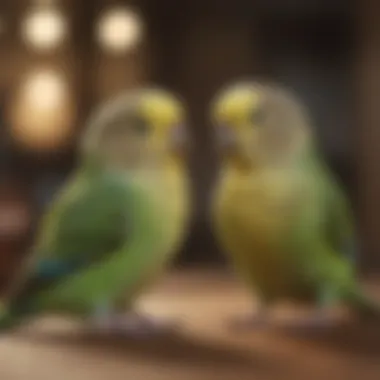
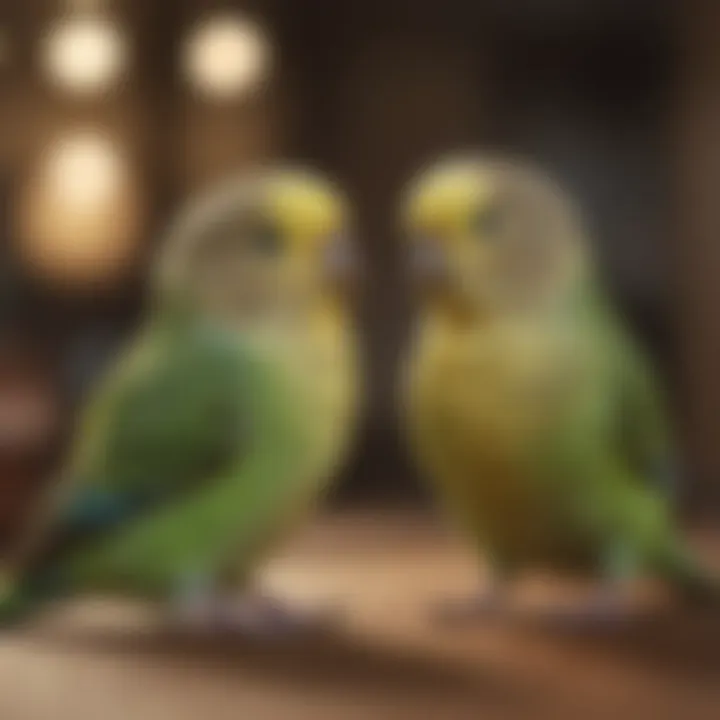
The specific habitat needs of Macaws, combined with their dietary requirements, makes regular care a commitment. Also, these birds can be particularly vocal, often engaging in loud calls. Potential owners should be prepared for the noise, as it can be a deciding factor for many households.
Behavioral Insights
Understanding the behavioral traits of Macaws adds an essential layer to their ownership. They are not just colorful pets; they thrive on interaction, attention, and mental stimulation. Macaws are known for being playful and sometimes mischievous, which can lead to entertaining but challenging situations.
One significant behavioral insight is their affectionate nature; they often seek physical contact and will enjoy cuddling and being close to their human companions. Owners will find themselves experiencing a unique bond that can be both rewarding and demanding. Yet, neglecting their social needs can lead to behavioral problems, including excessive squawking or aggression.
In sum, while the larger avian varieties, such as African Grey Parrots and Macaws, bring joy and companionship, it’s essential to recognize the care and commitment these magnificent birds require. Each aspect of their care, from cognitive stimulation to social interaction, plays a crucial role in ensuring they thrive as beloved pets.
Bird Species by Purpose
In the diverse world of pet birds, understanding their purpose is fundamental for making an informed choice for ownership. Whether seeking a bird for companionship or for show, each category offers distinct traits, requirements, and joys that can significantly shape the pet ownership experience. Recognizing these purposes not only enhances the relationship between birds and their owners but also promotes responsible ownership and care tailored to the specific needs of the species.
Companion Birds
Companion birds, as the name suggests, are bred and selected for their sociable nature and ability to form bonds with humans. Common examples include species such as parakeets, cockatiels, and budgerigars. The emphasis here is on interaction; these birds thrive in social environments, often seeking the company of their human caregivers. Their affectionate behavior offers emotional support, creating a unique companionship not dissimilar to that offered by traditional pets like dogs or cats.
Some key elements to consider when choosing a companion bird are:
- Personality Traits: Each species possesses individual temperament and quirks. For instance, cockatiels are known for their friendly disposition, while budgerigars might display a more exploratory nature.
- Social Needs: Companion birds require consistent interaction with their owners or other birds to remain emotionally stable. Boredom can lead to stress or behavioral issues, emphasizing the need for daily engagement.
- Caring Practices: Regular handling, talking, and playing are essential for developing a strong bond with your bird. It's worth allocating a few hours daily to invest in their social needs.
Overall, companion birds enrich their owners' lives, often forming strong emotional connections that can last for years. Their ability to provide joy and comfort makes them treasured members of many households, turning simple moments into cherished memories.
Show Birds
Show birds serve a distinct purpose from companion birds, focusing on standardization of breed characteristics, physical appearance, and competitive exhibition. Breeders often select birds based on specific traits that align with recognized standards set by avian societies. These activities provide a framework where enthusiasts can appreciate the beauty, diversity, and breeding excellence of various bird species.
When delving into the realm of show birds, it's important to consider:
- Evaluation Standards: Each bird is judged based on criteria such as color, size, and feather quality. Understanding these standards can enhance a breeder's commitment to improvement.
- Care and Maintenance: Show birds need extra attention to detail in their environment, diet, and grooming. Maintaining peak health and appearance is crucial for showcasing their best features.
- Community Engagement: Participating in competitions and exhibitions fosters a sense of community among breeders and bird owners. It creates opportunities for learning, sharing experiences, and celebrating avian beauty.
The show bird category not only emphasizes aesthetic qualities but also promotes responsible breeding practices within the community. As a result, show birds contribute significantly to the ongoing appreciation of avian diversity.
"Every bird is a little piece of art, a visual delight worthy of admiration and care."
By understanding the purpose behind different bird species—from companionship to showmanship—potential owners can make legacy choices that align with their lifestyle and goals. This awareness ultimately contributes to more fulfilling relationships with these remarkable feathered companions.
Understanding Bird Behavior
Understanding the behavior of pet birds is pivotal when it comes to fostering a healthy relationship between owners and their feathered companions. The nuances of bird behavior not only offer insight into their needs and preferences but also pave the way for more enriching interactions.
Birds, unlike many other pets, have highly social tendencies, and comprehending their behavioral patterns can help in providing them with fulfilling environments. Each bird species showcases unique behaviors influenced by their natural instincts, social structures, and communication styles. Being aware of these elements not only enhances bird owners’ ability to care for their pets but also supports the birds’ mental and emotional well-being.
Social Interactions
Bonding with Owners
Bonding with owners is a fundamental aspect of a pet bird's life. Engaging with a bird builds trust and affection, which can enrich both the bird's and owner's experiences. Birds thrive on interaction, and forming a bond helps them feel secure in their environment. A key characteristic of this bonding process is micro-interaction, where simple gestures, such as offering treats or gentle talking, can significantly strengthen the relationship.
One might find that such bonding leads to increased compliance from the bird during training. Moreover, birds that feel connected to their owners display more confidence in their behaviors, exploring their environment and vocalizing more freely. While it’s true that some species bond more easily, a dedicated owner can foster closeness regardless of the bird type. The only downside is the time it takes—birds benefit from regular interaction, and without it, they may become anxious or withdrawn.
Interactions with Other Birds
When discussing interactions with other birds, it becomes clear that social dynamics play a critical role in a bird’s overall health and happiness. Many species are naturally inclined to live in flocks, and these interactions teach them essential social skills. Observing how birds behave in groups can give fascinating insights into their hierarchy, communication, and playfulness. It’s common for owners to note that providing a companion bird often leads to more contentment.
The unique feature here is the play behavior displayed among social birds, which includes activities like chasing, preening, or mimicking sounds. These interactions not only keep them entertained but also satisfy their social needs. One must be cautious, however, as introducing new birds can lead to territorial disputes and stress if not managed carefully. Choosing the right mate or companion can help ensure a positive atmosphere for all involved.
Communication Styles
Vocalizations
Vocalizations represent a significant facet of bird communication, serving not only as artistic expression but also as a method for conveying feelings and warnings. Birds utilize a variety of sounds, from whistles to calls, indicating everything from hunger to alarm. Understanding these vocal patterns enriches the owner's comprehension of their pet's emotional state, fostering empathy and responsiveness.
The key characteristic of vocalizations is variability; each bird species has distinct sounds adapted to their environment. For example, African Grey Parrots are renowned for their mimicry abilities, which can be both entertaining and informative for owners looking to engage. While this feature makes for lively companionship, it’s vital to manage noise levels, as some species can be quite loud, potentially causing discomfort in shared living spaces.
Body Language
Body language is an equally essential element of bird communication. Unlike vocalizations, which can occasionally be misinterpreted, body posture often provides clearer signs of a bird's emotional state. Birds may puff themselves up when feeling threatened or expose their wings to signal contentment.
The unique feature of body language is its subtlety; small changes can indicate shifts in mood. By observing these cues, owners can respond appropriately, creating an environment that caters to the bird's needs. However, understanding these signals requires patience and consistent observation to truly appreciate how a bird communicates its feelings.
In summary, grasping bird behavior, from bonding to communication, is essential for creating a nurturing environment. By paying attention to both social interactions and communication styles, pet bird owners can build rewarding relationships with their avian companions, ultimately enhancing the birds' welfare. In the ever-evolving journey of companionship, these insights contribute immensely to a fulfilling pet ownership experience.
Avian Nutrition
When it comes to caring for pet birds, nutrition plays a pivotal role in their overall health and well-being. Inadequate diets can lead to various health issues, from feather abnormalities to serious organ dysfunction. Each species of bird has specific dietary requirements that must be tailored to ensure they receive the right balance of nutrients. Understanding these needs helps bird owners provide a supportive environment, improving both the longevity and quality of life for their feathered companions.
Furthermore, a well-rounded diet can enhance immunity, which is crucial for preventing diseases. It can also lead to vibrant plumage and energetic behavior, reflecting a bird's happiness and health. The significance of avian nutrition cannot be overstated; it's foundational for their physical health and psychological well-being.
Dietary Needs by Species
Different species of birds exhibit unique dietary needs. Here are some examples that illustrate this diversity:
- Budgerigars: These small parrots require a diet rich in seeds, fresh fruits, and leafy greens. A balanced budgie diet might include:
- Cockatiels: Cockatiels thrive on a varied diet. They need access to seeds but should also eat:
- African Grey Parrots: These intelligent birds require dry pellets, fresh veggies, and fruits to stay fit. Foods essential for African Greys include:
- High-quality seed mixes, specially formulated for budgies
- Fresh vegetables like spinach and carrots
- Fruits such as apples and bananas, offered in moderation
- Pellets designed for cockatiels as a staple base; these are often fortified with vitamins
- An assortment of vegetables, including bell peppers and broccoli, which provide essential nutrients
- Occasional treats from fruits like grapes or melons
- Calcium-rich foods like kale and broccoli
- Nuts in limited quantities, providing healthy fats
- Fortified pellets that offer a broad spectrum of vitamins and minerals
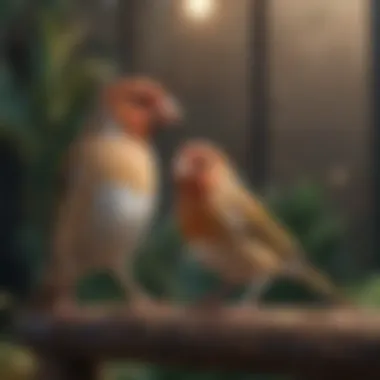
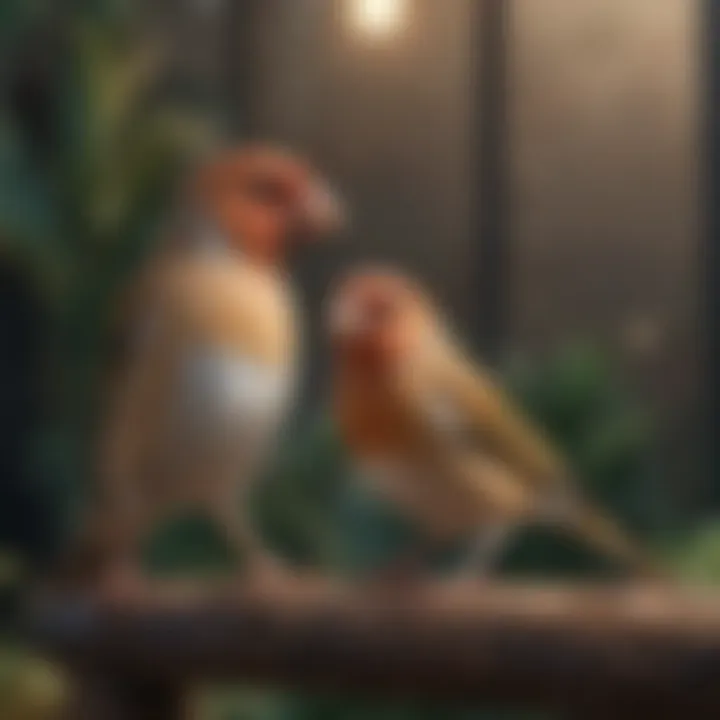
Each bird will also have individual preferences and possible dietary restrictions. It’s vital for avian owners to observe their birds and make adjustments accordingly.
Common Dietary Mistakes
Even experienced bird owners can fall into the trap of dietary errors. Here are some prevalent mistakes:
- Over-reliance on Seeds: Seeds often dominate the diet, but they lack essential nutrients if fed exclusively. Many seeds are high in fat and low in vitamins, which can lead to obesity and deficiencies.
- Neglecting Fresh Foods: Birds that eat only pellets or seeds might miss out on the vital minerals and vitamins found in fresh fruits and vegetables. This oversight can result in health issues in the long term.
- Offering Unhealthy Treats: Human foods—especially those that are fried, sugary, or processed—are harmful to birds. Owners should resist the temptation to share their meals, as what’s good for humans can be toxic for birds.
- Ignoring Preparation: Some fruits and veggies require preparation before consumption. For instance, avocado is toxic to many bird species but might mistakenly be offered unprepared.
- Lack of Variety: Birds enjoy a diverse diet. A monotonous diet can lead to nutritional deficiencies and boredom, manifesting as behavioral issues. Regularly introducing new safe foods can keep the diet interesting.
By recognizing the unique dietary needs of their pets and avoiding common pitfalls, bird owners can lay a strong foundation for their pet's health. With proper nutrition, pet birds will thrive, showcasing their vibrant colors and lively personalities in every chirp and flutter.
Health and Wellness
Caring for a pet bird is not just about providing food and a cage; it involves understanding the health and wellness aspects that ensure your avian friend thrives. Good health is essential for a happy, active bird that can enjoy life to its fullest. In this section, we will delve into preventive care and recognizing health issues—two critical components of responsible pet ownership.
Preventive Care
Preventive care serves as the cornerstone of keeping your bird in peak condition. It includes regular vet check-ups, proper nutrition, and maintaining a clean habitat. Here are a few vital points:
- Routine Veterinary Visits: Just like a dog or cat, birds need regular health check-ups. These vet visits can catch potential issues early, before they turn serious. A good avian vet will also help you with vaccinations that might be necessary depending on your bird's species and environment.
- Balanced Diet: A nutritious diet is crucial for maintaining your pet's health. Different bird species have varied dietary requirements, so understanding what your feathered companion needs is fundamental. Ensure they get a mix of seeds, fruits, vegetables, and specialized pellets tailored to their nutritional needs.
- Clean Environment: Keeping your bird's living space clean can prevent various health issues. Regularly wash the cage, change the bedding, and ensure that food and water containers are spotless. Birds are sensitive creatures and exposure to dirty environments can lead to respiratory infections or other ailments.
- Socialization: Birds are social animals. Regular interaction not only keeps them mentally stimulated but also supports their emotional health. Spend time talking, playing, and bonding with your feathered friend to boost its wellbeing.
"An ounce of prevention is worth a pound of cure." Ensuring your bird's health through preventive measures can lead to a happier life for both you and your pet.
Recognizing Health Issues
Being attuned to your bird's behavior and physical condition is crucial in spotting potential health problems. Birds often hide their discomfort until it becomes severe, so observing small changes can be key.
- Behavior Changes: If your bird is less active than usual or has lost interest in play, it may indicate health issues. Pay attention to changes in their vocalizations too, as decreased chirping can signal trouble.
- Physical Signs: Look for signs such as ruffled feathers, a change in appetite, or unusual droppings. For instance, watery droppings may suggest a dietary imbalance or illness. Ensuring you can recognize these signs quickly can save your bird.
- Weight Monitoring: Keeping an eye on your bird’s weight can be a significant indicator of health. Weight fluctuations can hint at underlying conditions. Ideally, you should consult with a vet on the best way to track your bird’s weight.
- Regular Health Checks: Make it a habit to gently examine your bird. Check its beak, feet, and feathers for any irregularities. Familiarizing yourself with what is normal can help you identify when something is off.
Addressing health and wellness from the start prepares you not just as an owner but as a responsible friend to your pet bird. With the right preventive care and a keen eye for health issues, you lay a foundation for a long, healthy relationship with your avian companion.
Creating a Suitable Living Environment
Creating a suitable living environment for pet birds cannot be overstated. It’s like setting the stage for a play—without the right scenery and props, the performance simply won’t shine. A well-structured habitat is not only about aesthetics but also plays a critical role in the overall well-being of these feathered companions.
The right environment considers a variety of factors that work together harmoniously. First off, the size of the bird’s cage has a strong influence on their happiness. Smaller birds need less space but still require enough room to flap their wings and move around comfortably. Larger species demand expansive enclosures, where they can stretch and exercise. Furthermore, positioning the cage is key; a spot that balances sunlight with a touch of shade can make a world of difference.
Moreover, cleanliness cannot be downplayed. Regular maintenance is necessary to prevent health issues arising from bacteria and mold. Also, the inclusion of familiar scents and textures can offer comfort to pet birds as they settle into their new environments.
"An enriched environment can transform a cage into a haven, encouraging birds to explore and exhibit their natural behaviors."
Cage Selection
Selecting the right cage is akin to choosing a home for a family; it deserves careful consideration. Ideally, the cage should be spacious enough for birds to move freely, with horizontal bars for climbing as many birds enjoy this activity. The bar spacing is also crucial; too wide and a small bird might escape, too narrow and it may be uncomfortable.
Material matters too. Stainless steel is often praised for its durability and ease of cleaning. Avoid cages with painted surfaces, as birds might chew on them, potentially leading to health issues. Equipment, such as perches and feeders, should be thoughtfully arranged within the cage; varied perches of differing thickness can keep their feet healthy and help mimic a natural setting.
Environmental Enrichment
Environmental enrichment is an essential element for a happy, healthy bird. Just like humans, birds thrive in dynamic settings that stimulate their brains and bodies. Boredom can lead to destructive behaviors, so engaging their senses with various stimuli is important.
Toys and Activities
Toys and activities serve as a recipe for mental stimulation among pet birds. They can reduce stress and promote physical activity, making them a beneficial addition to any bird's life. From climbing ropes to shreddable toys, the options are vast.
One unique feature of toys is their diversity in textures. Wooden chew toys promote natural chewing instincts, while plastic toys are often brightly colored, capturing a bird’s attention. These not only keep birds entertained but also aid in their dental health. On the flip side, it’s crucial to ensure toys don't have small parts that could lead to choking hazards.
Social Interaction
Social interaction is fundamentally important in a bird’s life. Birds are inherently social creatures that often thrive on companionship, whether it's from their human owners or fellow avian friends. Regular interaction can strengthen the bond between a bird and its owner, reducing feelings of loneliness.
Having a second bird can be an ideal way to satisfy this need, but it does come with its own sets of considerations. Not all species mix well, and introducing new birds should be done gradually. The presence of a companion can ensure that the birds engage in natural social behaviors, thus boosting their well-being. While social interactions are advantageous, misfitting personalities can lead to conflicts, so monitoring their behavior is key.
Ultimately, the goal in creating a suitable living environment for pet birds is to mimic as closely as possible their natural habitat. By carefully selecting cages, providing toys, and encouraging interactions, bird owners can foster a thriving atmosphere that keeps their feathered friends engaged and healthy.
Training and Behavior Modification
Training and behavior modification are pivotal elements in ensuring a harmonious existence between pet birds and their owners. Establishing clear communication and reinforcing desirable behaviors can lead to more enjoyable interactions, elevating the bond between pet and caretaker. Moreover, a well-trained bird is less likely to demonstrate nagging tendencies and can even engage in entertaining tricks that bring joy to both the bird and its owner.
Understanding that each bird species has its particular attributes is essential. Training techniques may vary based on a bird's personality, age, and prior experiences. Basic training serves as a foundation for fostering positive behaviors while addressing unwanted ones. Here, we'll delve into some effective methods and considerations for training and behavior modification in pet birds.
Basic Training Techniques
- Positive Reinforcement: This is the crux of successful bird training. Reward your feathered companion with treats, praises, or affection when they exhibit a desired behavior. This encourages them to repeat the action. You may want to use small bits of fruit or vegetables as rewards, but be cautious not to overfeed.
- Consistency is Key: Birds thrive on routine. Use the same commands and gestures every time you train. For instance, if you teach your parakeet to step onto your finger, always use the same prompt, such as "step up."
- Short Training Sessions: Keep training periods brief, about 5 to 10 minutes, to maintain your bird's attention span and prevent frustration. Several short sessions throughout the day are better than long and tiresome ones.
- Clicker Training: This method involves using a clicker as a marker for correct behaviors. When your bird performs the desired action, click the device and provide a treat. This can create a strong association between the behavior and the reward.
- Social Interaction: Birds are inherently social creatures; engaging with them and allowing them to observe their owners’ behaviors often encourages learning. Incorporating interactive play can also enhance the training process.
"Establishing a strong foundation in training can save a bird owner from potential headaches in the long run."
Addressing Problem Behaviors
Even with training, some pet birds may exhibit behaviors that could be problematic. Identifying and modifying these actions is vital for both the bird's welfare and the owner's peace of mind. Here are a few common issues and how to tackle them:
- Excessive Squawking: Many birds are vocal, but loud, repetitive squawking can become a nuisance. To manage this, consider identifying the trigger for the noise—boredom, loneliness, or even mimicry—and develop a strategy to address it. Providing more toys or schedule playtime can help fend off boredom.
- Feather Plucking: This self-destructive behavior may arise from stress, a lack of stimulation, or health problems. If you notice your bird plucking feathers, consult an avian vet to rule out medical issues and invest time in enriching their environment with interactive toys and socialization.
- Biting: A bird that bites can often be acting out of fear or a lack of trust. It’s important not to react harshly to biting; this could escalate the problem. Instead, focus on gentle handling and reward calm behavior. Gradually approaching the bird during interaction can help build trust.
- Destructive Chewing: Birds, especially when young, love to chew. Providing appropriate toys to chew on can redirect this instinct away from household items. Rotate toys regularly to keep their interest piqued.
Ending
In summary, understanding the myriad facets of pet bird ownership is critical for both current and potential caretakers. The journey of having a feathered friend is not simply about choosing the right species; it encompasses a wide array of considerations that can make or break the harmony within one’s home.
The Importance of Informed Ownership
Informed ownership is the cornerstone of nurturing a thriving avian companion. With the unique needs of each bird species, it's vital to gather knowledge tailored to their specific traits and care requirements. Not all birds are the same, and the differences can be quite pronounced when it comes to diet, social interaction, and housing needs. For example, large birds like the African Grey Parrot have complex behavioral patterns that require extensive mental stimulation, while smaller birds like canaries thrive in a more serene, solitary environment.
This depth of understanding facilitates better care practices and fosters a more fulfilling bond between the bird and owner. An owner well-versed in the nuances of their pet's needs can notice subtle shifts in behavior that may indicate stress or illness, addressing potential problems before they escalate.
Moreover, owning a pet bird comes with its set of responsibilities. Aside from daily care and maintenance, educating oneself about avian health can prevent many common ailments. Recognizing signs of distress or changes in eating habits can lead to timely veterinary visits, ensuring that the pet remains happy and healthy.
Benefits of Informed Ownership:
- Enhances the quality of life for your pet bird
- Strengthens the bond between the owner and the bird
- Minimizes health risks through proactive care
- Provides a fulfilling experience that enriches both the bird's and owner's lives
In essence, the commitment to being an informed bird owner can transform simple companionship into a rich, rewarding relationship. Every individual seeking the joys of avian companionship should take the time to educate themselves thoroughly—not just for their sake, but for the happiness and well-being of their feathered friends.















